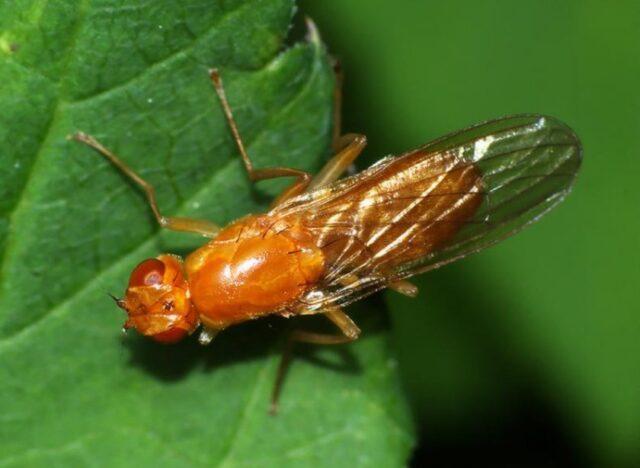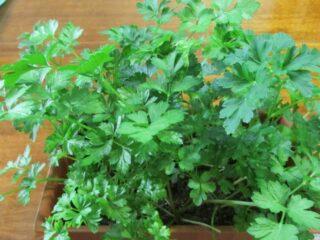Content
Parsley Italian giant is a variety of foreign origin. In 2007, it was included in the State Register of the Russian Federation, classifying it as a horticultural crop based on its growing conditions. The Italian giant quickly gained consumer recognition due to its high yield, large juicy foliage, good immunity and other advantages.
Description and characteristics of parsley variety Italian giant
Leaf parsley Italian giant grows up to 67 cm. Main characteristics:
- semi-vertical sockets;
- dark green triangular leaves with deep lobar cuts;
- petioles are small, thickness is average;
- stems are dense;
- The aroma is pronounced, tart.
For greens, Italian giant parsley is usually grown as an annual crop. If you leave it for the second year, greenish-yellow flowers will appear, after which the seeds will ripen.They can be collected for cultural propagation, use in cooking, cosmetic purposes, and traditional medicine.
Productivity
The Italian giant is characterized by high productivity. Each bush produces approximately 20-25 leaves with a total weight of 75 g. From 1 m² during the season you can collect 3-5 kg of greenery.
When it ripens
The Italian giant is a mid-season variety. The first shoots can be seen after 3-4 weeks. From the moment of their appearance, full ripening of parsley takes 90 days.
Drought and frost resistance
The Italian giant has good frost resistance. Parsley growth does not stop until -10 °C. The variety tolerates frost well, which allows the crop to be planted in different seasons. She doesn't like drought.
Pros and cons of the variety
Gardeners and gardeners fell in love with the Italian giant for its large size and juicy, aromatic greens. This parsley can be grown in any region of the Russian Federation.

The Italian giant produces a good harvest even in shaded areas under unfavorable weather conditions
Pros:
- excellent taste;
- fragrant and juicy greens;
- high productivity;
- frost resistance;
- good immunity;
- Possibility of cultivation all year round;
- unpretentiousness to growing conditions;
The main disadvantage of the Italian giant, which is also inherent in other varieties, is the slow germination of seeds. This feature is associated with the high content of essential oils in the shell.
Landing rules
The success of growing parsley largely depends on the right location and proper seed preparation. You can sow the Italian giant three times a year:
- spring – end of April or beginning of May;
- summer - end of July;
- autumn – October, November.
When choosing sowing dates, be sure to take into account the climatic features of the region.
Seed preparation
Parsley seeds are prepared to speed up the emergence of seedlings. This measure is only needed for spring planting. Preparing the seed involves soaking it, during which the shell softens and the essential oils are washed out of it. There are several options:
- soaking for 24 hours in warm water - optimal temperature 40-45 °C;
- hydrogen peroxide – keep the seeds in undiluted liquid for 15-20 minutes, then rinse;
- alcohol (vodka) – soak the seed for 10-15 minutes, then rinse.
To prevent diseases, seeds are kept in a weak solution of potassium permanganate or aloe juice. Stimulating drugs such as Heteroauxin help accelerate growth.
After treatment with the selected means, the seeds are dried for several hours. Otherwise, they will stick together and stick to your fingers.
Site selection and preparation
Parsley is unpretentious and can be grown in almost any conditions. The Italian giant produces maximum yield and lush greenery with the following factors:
- illuminated area;
- place after cauliflower, cucumbers, zucchini, potatoes;
- the soil is light, rich in humus, preferably loam or sandy loam;
- moderate soil moisture;
- groundwater distance from 1 m;
- the optimal pH level is 6.5-7.
If you plant Italian giant parsley in the spring, the site should be prepared in the fall. Be sure to dig up the ground, remove weeds, and add per 1 m²:
- humus or rotted manure – 3 kg;
- wood ash – 0.3 kg;
- nitroammophoska – 1 tbsp. l.

Parsley feels good in mixed plantings with cucumbers, tomatoes, peppers, radishes, and peas
Step-by-step instruction
Before planting Italian giant parsley, the soil needs to be loosened and complex mineral fertilizer applied. After preparing the seeds, proceed as follows:
- Make grooves at intervals of 20 cm. A depth of 1-1.5 cm is sufficient.
- Pour warm water over the grooves and wait for absorption.
- Sow the seeds.
- Sprinkle with soil.
- Level the surface and compact it slightly.
To speed up the germination of parsley, a film is spread on the bed with crops. After emergence of seedlings, the shelter is removed.
Italian giant parsley can be planted using the conveyor method in spring and summer. Sowing is done every 2-3 weeks until the end of July. This method allows you to extend the harvest time and get fresh herbs longer for the table or for sale.
For winter sowing of Italian giant parsley, dry seeds are used. The furrows are not watered before planting.
Features of care
Parsley The Italian giant is unpretentious in care. Culture needs a standard set of activities.
Loosening and weeding
Systematic loosening of Italian giant parsley is necessary for soil breathability and moisture retention. The procedure must be performed after watering or heavy rain.
Weeds interfere with the growth and development of crops and contribute to the development of diseases and pests. Regular weeding is carried out in dry weather. Weeds can be removed manually or combined with loosening using a flat cutter, hoe, hoe, or rake. Afterwards, the plantings should be mulched. A layer of up to 3 cm is sufficient.Mulch is needed to retain moisture and prevent weeds.
Thinning
Parsley The Italian giant grows over time. Because of this, not all shoots receive enough sunlight, water and nutrients. This has a bad effect on the growth and development of the crop and its marketability. The problem is solved by systematic thinning of plantings.
Watering
Parsley Italian giant prefers moderate moisture. The soil should not dry out, but frequent heavy watering has a bad effect on the crop. If the weather is rainy, it is not needed at all. In hot weather, moderate watering every two days is recommended. It should be done early in the morning or after sunset.

To water Italian giant parsley, it is better to use water at room temperature.
Feeding
If the site for planting Italian giant parsley has been properly prepared, it is enough to apply fertilizer three times per season:
- four days after emergence;
- again in a week;
- a month before harvest.
The first two feedings should be nitrogen in order to stimulate the growth of green mass. For 1 m², 5-6 g of fertilizer is enough. Before harvesting, potassium-phosphorus compounds are needed. You can add 1 tsp per 1 m². potassium salt, superphosphate or 0.2 kg of wood ash as mulch.
Protection from diseases and pests
The Italian giant has good immunity. The crop can be affected by rust. The disease manifests itself as convex formations of a dirty red color. Affected leaves dry out and fall off. Diseased parts of plants are removed, and drugs are used for treatment:
- Fitosporin;
- Topaz;
- Abiga Peak;
- Baktofit;
- Bordeaux mixture.

To prevent rust, deep autumn digging of the soil, removal of plant residues, and adherence to agricultural practices are important.
Among the pests, parsley is often affected by the carrot fly. The leaves acquire a reddish-purple color, then turn yellow. There are several methods of struggle:
- folk remedies - tobacco palm, decoction of tomato tops, yarrow, infusion of onion or garlic;
- drugs – Decis, Fitoverm, Volaton, Karate, Stefesin.

To prevent carrot flies, it is important to observe crop rotation, thin out plantings, and not overuse watering
Harvest and storage
You can harvest Italian giant parsley at any time after it ripens. Trim the stems to the root. If you collect only the tops and leave the petioles, the growth of young shoots will slow down greatly.
For food, cut parsley stems from the outside of the bush. With this approach, the foliage becomes lush and more fragrant.
It is important to harvest parsley before the outside temperature reaches 5 °C. Sort through the greens as quickly as possible, rinse in running water, and dry on a towel.
Italian giant parsley remains fresh for several days after cutting. For the winter, greens can be dried in sprigs or sliced outdoors, in an oven or electric dryer. Store the workpiece in paper bags, linen bags or sealed glass or ceramic jars.
To preserve the maximum of valuable elements, it is better to freeze parsley. You can prepare it in twigs or cut it first. There are several options:
- storage in containers or bags;
- freezing greens with water, use an ice tray;
- preparation in butter - melt it, pour in chopped parsley, freeze in molds.
Another option is storage in salt. The greens are chopped, sprinkled with seasoning and placed in dry and clean glass jars. The preparations are stored in the cellar or refrigerator.
Conclusion
Italian giant parsley is a mid-season variety with juicy, aromatic and large leaves. The culture is unpretentious in care, has good immunity and resistance to frost. Seeds take a long time to germinate; the process can be speeded up with proper preparation.
Reviews of Italian parsley








